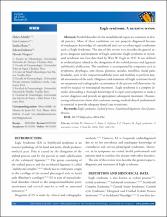Eagle syndrome. A narrative review.

View/
Download
(application/pdf: 200.6Kb)
(application/pdf: 200.6Kb)
Date
2016-09-14Author(s)
Arbildo Vega, Heber Isac
Gamarra, Luis Gustavo
Rojas, Sandra Vannesa
Infantes, Edward Demer
Vásquez, Hernán
Metadata
Show full item recordAbstract
Painful disorders in the maxillofacial region are common in dental practice. Most of these conditions are not properly diagnosed because of inadequate knowledge of craniofacial and cervico-pharyngeal syndromes such as Eagle Syndrome. The aim of this review is to describe the general aspects, diagnosis and treatment of Eagle syndrome. Eagle syndrome or stylohyoid syndrome was first described by Watt W. Eagle in 1937. It was defined as orofacial pain related to the elongation of the styloid process and ligament stylohyoid calcification. The condition is accompanied by symptoms such as dysphonia, dysphagia, sore throat, glossitis, earache, tonsillitis, facial pain, headache, pain in the temporomandibular joint and inability to perform lateral movements of the neck. Diagnosis and treatment of Eagle syndrome based on symptoms and radiographic examination of the patient will determine the need for surgical or nonsurgical treatment. Eagle syndrome is a complex disorder demanding a thorough knowledge of its signs and symptoms to make a correct diagnosis and provide an appropriate subsequent treatment. Disseminating information about this syndrome among medical-dental professionals is essential to provide adequate dental care to patients.
Collections
- Artículos [274]







